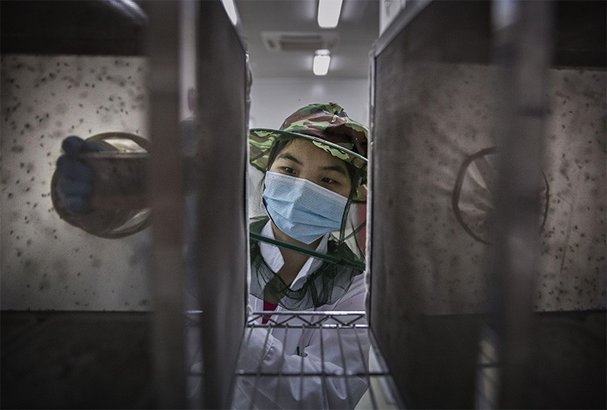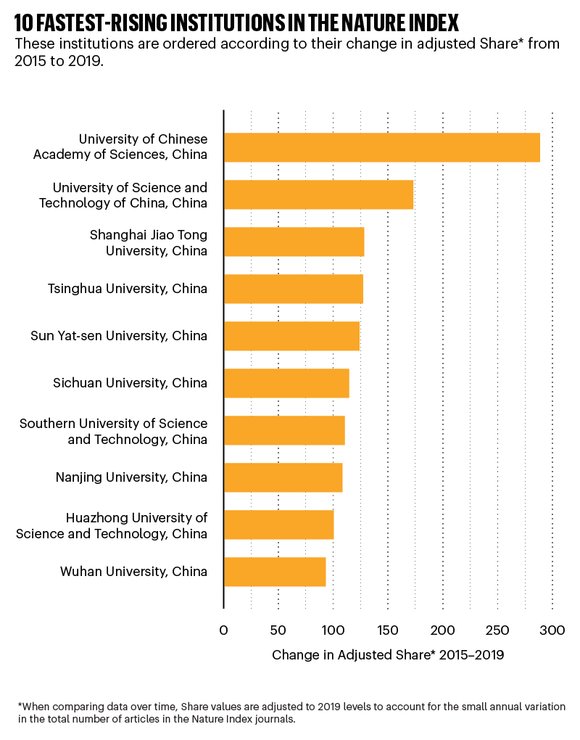
A lab technician places mosquito pupa into a cage at the Sun Yat-sen University-Michigan University Joint Center of Vector Control for Tropical Disease, considered to be the world's largest mosquito factory.
Credit: Kevin Frayer/Getty
Fast-rising research institutions in the Nature Index 2020 Annual Tables
These institutions have achieved significant increases in research output in the Nature Index since 2015.
30 April 2020

Kevin Frayer/Getty
A lab technician places mosquito pupa into a cage at the Sun Yat-sen University-Michigan University Joint Center of Vector Control for Tropical Disease, considered to be the world's largest mosquito factory.
The University of Chinese Academy of Sciences (UCAS) in Beijing is the fastest-rising institution in the Nature Index 2020 Annual Tables (see Graphic).
Its change in adjusted Share from 2015 to 2019 was 288.61, representing a 242% increase over 4 years. (When comparing data over time, Share values are adjusted to 2019 levels to account for the small annual variation in the total number of articles in the Nature Index journals.)
In second position is the University of Science and Technology of China (USTC) in Hefei, which is also second in the top 25 fastest-rising institutions in chemistry.
In the Nature Index global top 10 for 2020, USTC appears in eighth position. (The Nature Index is one indicator of institutional research performance. See Editor’s note below.)
All but one of the top 50 rising institutions in the 2020 Annual Tables are from China. The exception is Colorado State University in Fort Collins, in 45th position. See the 2020 Annual Tables Top 100 fastest-rising institutions for 2019.

Here is a selection of institutions from the top 30 of the Nature Index 2020 Annual Tables — rising stars.
Shanghai Jiao Tong University, China
Change in adjusted Share (2015–19): 128.29; % change: 110.3%; Place: 3rd
China’s Shanghai Jiao Tong University (SJTU) is rapidly climbing the ranks in high-quality research in journals tracked by the Nature Index.
The 123-year-old Shanghai-based university supports 3,014 full-time faculty members, including 22 members of the Chinese Academy of Sciences and 24 members of the Chinese Academy of Engineering. It is also home to seven State Key Laboratories — facilities that receive funding and administrative report from the Chinese government.
A 2019 Nature paper involving SJTU researchers found that body-mass index is increasing at the same rate or faster in rural areas than in cities in low- and middle-income regions. According to Altmetric, the study was shared by more than 800 Twitter users and nearly 60 online news outlets.
Sun Yat-sen University, China
Change in adjusted Share (2015–19): 124.01; % change: 91.8%; Place: 5th
Located in the city of Guangzhou in the Guangdong province of southern China, Sun Yat-sen University (SYSU) opened its doors almost 100 years ago. Since 2015, it has been making impressive gains in natural-sciences research published in journals tracked by the Nature Index.
SYSU comprises five campuses located in Guangzhou, Zhuhai and Shenzhen and ten affiliated hospitals, including the Sun Yat-sen Cancer Center, which was ranked among the top 50 health-care institutions in the world in the Nature Index 2019 Annual Tables. In 2019, its research funding totalled 3.14 billion yuan (US$442 million).
In 2019, SYSU researchers were part of an international team that used genetic data from more than 500,000 people to predict whether individuals will live longer or die sooner than the average global lifespan. The eLife study was one of the most popular papers involving SYSU researchers last year.
Southern University of Science and Technology, China
Change in adjusted Share (2015–19): 110.58; % change: 622.3%; Place: 7th
Located in the innovation hub of Shenzhen, a major city in southeastern China, the Southern University of Science and Technology (SUSTech) is a young public university that has made remarkable gains since its establishment less than a decade ago.
Ranked seventh in the Nature Index 2019 Young Universities, it is a rapidly rising star, also placed within the top 10 universities in mainland China in the Times Higher Education World University Rankings 2020.
Established in 2012, SUSTech made its mark early by offering salaries equivalent to those of leading US and European universities. Today, more than 90% of its faculty members and staff have worked and studied at overseas institutions.
As of late 2019, SUSTech had 4,205 undergraduate and 2,214 graduate students and 800 faculty members. Its scientists have published high-impact research in journals such as Science, Nature and Advanced Materials.
Shenzhen University, China
Change in adjusted Share (2015–19): 66.79; % change: 609.6%; Place: 15th
Following Shenzhen University’s establishment in Shenzhen, China, in 1983, two of China’s top universities, Peking and Tsinghua, seconded teaching staff to the fledgling institution. Today, it is a rising star in high-quality research in the natural sciences.
High-profile alumni who cut their teeth at Shenzhen University include computer scientist, Ma Huateng, who is the founder and chief executive of the Chinese social media behemoth, Tencent, and software engineer, Shi Yuzhu, who set up the online gaming company, Giant Interactive Group.
Among the biggest advances Shenzhen University researchers contributed to in 2019 were a light-activated metal compound that can kill cancer cells (Nature Chemistry) and the sequencing of the entire peanut genome (Nature Genetics).
Tongji University, China
Change in adjusted Share (2015–19): 49.75; % change: 77.1%; Place: 27th
Established in Shanghai in 1907, Tongji University quickly became one of China’s leading comprehensive universities in the first half of the twentieth century, but it suffered through the national higher-education reshuffle starting in 1949. Most of its social sciences, law, medical sciences and natural sciences were moved to other universities during this time, and it received researchers in engineering, particularly civil construction, in return.
Tongji University has maintained its strength in civil construction and industrial engineering to this day, and in 2017 was selected by China’s Ministry of Education as one of four universities in Shanghai to join its Double First Class University Plan, an initiative to strengthen the national university system.
In 2019, Tongji University enrolled 18,115 undergraduate, 17,871 graduate, and 3,575 international students. Its 2,803 full-time faculty members include 27 members of the Chinese Academy of Sciences and Chinese Academy of Engineering, 36 full-time Changjiang scholars honoured by the Ministry of Education, and 62 recipients of the Distinguished Young Scientist award from the National Natural Science Foundation of China.
This story is part of Nature Index 2020 Annual Tables. See more stories here.
For a description of the terminology and methodology used in this supplement, please see our guidelines here.
Editor’s note: The Nature Index is one indicator of institutional research performance. The metrics of Count and Share used to order Nature Index listings are based on an institution’s or country’s publication output in 82 natural-science journals, selected on reputation by an independent panel of leading scientists in their fields. Nature Index recognizes that many other factors must be taken into account when considering research quality and institutional performance; Nature Index metrics alone should not be used to assess institutions or individuals. Nature Index data and methods are transparent and available under a creative commons licence at natureindex.com.
